Sound design for underground metal presents unique challenges, such as achieving clarity in dense mixes and balancing aggressive instrumentation. Key techniques include layering, distortion, and dynamic range control. Recommended software tools like Pro Tools and Ableton Live enhance the production process, offering advanced audio editing and mixing capabilities. Understanding subgenre variations and production techniques is essential for creating a powerful and authentic sound.
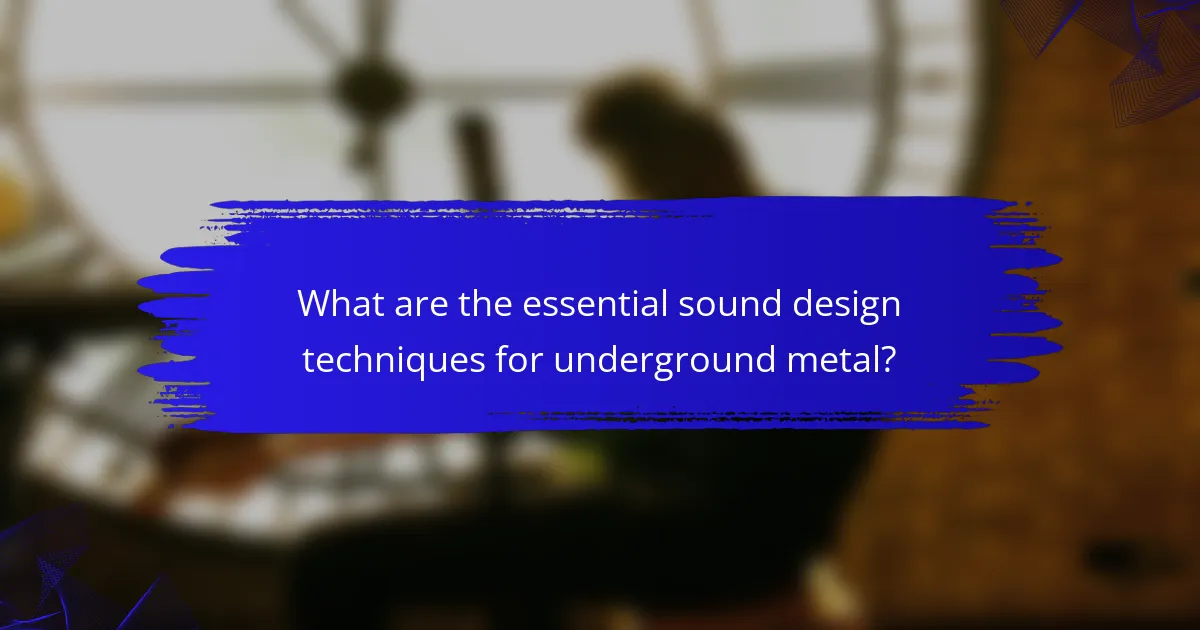
What are the essential sound design techniques for underground metal?
Essential sound design techniques for underground metal include layering, distortion, and dynamic range control. These techniques enhance the genre’s aggressive sound while ensuring clarity and impact.
Layering involves combining multiple tracks to create a fuller sound. This can include stacking guitars, adding harmonies, or blending different vocal styles. Distortion is crucial for achieving the gritty tones typical in underground metal, often applied to guitars and vocals for added aggression. Dynamic range control ensures that the loudest and softest parts of a track are balanced, maintaining energy without sacrificing clarity.
Software recommendations include digital audio workstations (DAWs) like Ableton Live or Pro Tools, which provide robust tools for sound manipulation. Plugins such as Guitar Rig or Bias FX are excellent for achieving desired distortion effects. Additionally, using EQ and compression plugins can help fine-tune the mix, ensuring each element stands out in the overall sound.
How do layering and texturing enhance sound in metal music?
Layering and texturing significantly enhance sound in metal music by creating depth and complexity. These techniques add richness to the overall sonic landscape, allowing for a more immersive listening experience. Layering involves stacking multiple sound sources, such as guitars and vocals, which generates a fuller sound. Texturing introduces various effects, like reverb and delay, to enrich individual elements and create atmosphere. This combination helps define the genre’s aggressive yet nuanced character, making it essential for effective sound design.
What role does distortion play in shaping the underground metal sound?
Distortion is essential in shaping the underground metal sound by adding grit and aggression. It enhances the rawness and intensity, creating a powerful auditory experience. Techniques like overdrive and fuzz pedals are commonly used to achieve this effect. Distortion not only thickens the guitar tone but also contributes to the overall atmosphere, making it darker and more immersive. Software plugins can replicate these effects, allowing musicians to experiment with various distortion settings, further defining their unique sound.
How can reverb and delay be effectively utilized in metal tracks?
Reverb and delay enhance metal tracks by creating depth and atmosphere. Use reverb to simulate space and add sustain, while delay can create rhythmic complexity and layering. Experiment with different types of reverb, such as plate or hall, to achieve desired effects. For delay, consider using syncopated settings to complement the aggressive nature of metal.
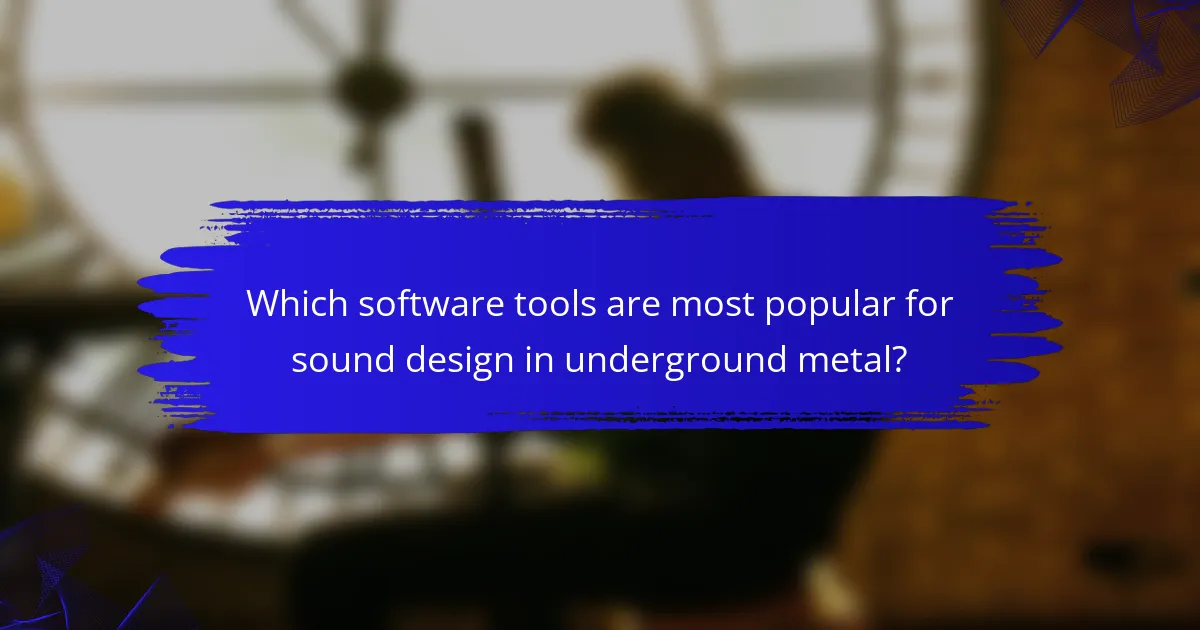
Which software tools are most popular for sound design in underground metal?
Popular software tools for sound design in underground metal include Pro Tools, Ableton Live, FL Studio, and Cubase. These platforms offer advanced audio editing, mixing capabilities, and a range of plugins that enhance the metal sound. Pro Tools is known for its professional-grade audio mixing, while Ableton Live excels in live performances. FL Studio provides a user-friendly interface with powerful synthesizers, and Cubase is favored for its MIDI capabilities. Each tool supports unique attributes that cater to different aspects of sound design, making them essential for metal producers.
What are the advantages of using digital audio workstations (DAWs) like Pro Tools and Ableton Live?
Digital audio workstations (DAWs) like Pro Tools and Ableton Live enhance sound design for underground metal through advanced features and flexibility. They offer powerful audio editing capabilities, extensive plugin support, and intuitive interfaces that streamline the creative process.
Pro Tools excels in professional studio environments, providing high-quality audio recording and editing tools. Its robust mixing capabilities and industry-standard plugins make it ideal for complex arrangements.
Ableton Live, on the other hand, is designed for live performance and rapid composition. Its session view allows for real-time manipulation of audio clips, making it suitable for experimentation and improvisation in underground metal.
Both DAWs support MIDI integration, enabling musicians to create intricate compositions and soundscapes. Their unique attributes cater to different aspects of sound design, ensuring that artists can achieve their desired sonic outcomes efficiently.
How do plugins like Guitar Rig and AmpliTube contribute to metal sound design?
Plugins like Guitar Rig and AmpliTube enhance metal sound design by providing versatile tone-shaping tools. They offer a range of amp models, cabinet simulations, and effects that allow musicians to create unique sounds tailored to underground metal styles. Guitar Rig features customizable signal chains, enabling intricate layering and experimentation, while AmpliTube focuses on realistic amp emulations, delivering authentic tones. Both plugins support various input methods, accommodating different playing styles. Their user-friendly interfaces streamline the creative process, making them essential for metal producers seeking to achieve powerful, distinctive soundscapes.
What unique features do specialized software tools offer for metal producers?
Specialized software tools for metal producers offer advanced features like real-time monitoring, predictive analytics, and automated reporting. These tools enhance efficiency, reduce downtime, and improve product quality. Unique attributes include customization options for specific production processes and integration capabilities with existing systems. Rare features may involve machine learning algorithms that optimize production based on historical data.
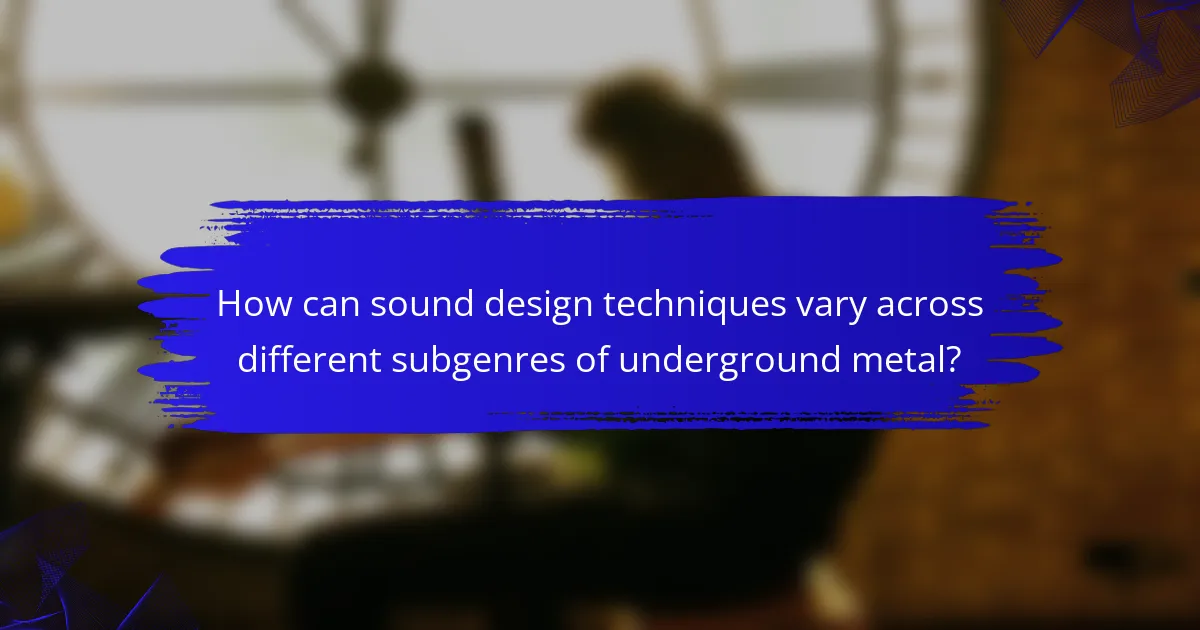
How can sound design techniques vary across different subgenres of underground metal?
Sound design techniques in underground metal vary significantly among subgenres, reflecting their unique characteristics. For instance, black metal often employs atmospheric soundscapes and reverb-heavy guitars, while death metal focuses on aggressive tones and complex rhythms.
Techniques include layering instruments to create depth, using distortion to enhance intensity, and experimenting with unconventional time signatures. Software recommendations vary by subgenre; black metal producers may favor plugins that simulate analog warmth, whereas doom metal creators might use heavy reverb and delay effects.
In terms of production, the choice of mic placement and recording techniques can drastically affect the final sound. For example, close-miking techniques can capture the raw energy of thrash metal, while ambient miking suits the expansive nature of post-metal.
Ultimately, understanding these variations helps producers tailor their sound design to fit the specific aesthetic of each underground metal subgenre.
What characteristics define the sound of black metal versus death metal?
Black metal features high-pitched, shrieking vocals and atmospheric guitar riffs, while death metal emphasizes growled vocals and heavier, more aggressive instrumentation. Both genres utilize distinct sound design techniques that shape their unique auditory identities. Black metal often incorporates reverb and tremolo picking, creating a cold, haunting atmosphere. In contrast, death metal relies on down-tuned guitars and complex rhythms, resulting in a dense, powerful sound. Understanding these characteristics can enhance sound design in underground metal production.
How does sound design differ in doom metal compared to thrash metal?
Sound design in doom metal emphasizes heavy, slow tempos and dense, layered guitar tones, while thrash metal focuses on fast tempos and sharp, aggressive riffs. Doom metal utilizes reverb and distortion to create an atmospheric sound, whereas thrash metal employs tight, precise production to highlight speed and technicality. Both genres use similar software tools, like digital audio workstations and plugins, but their application varies based on the desired sonic outcome.
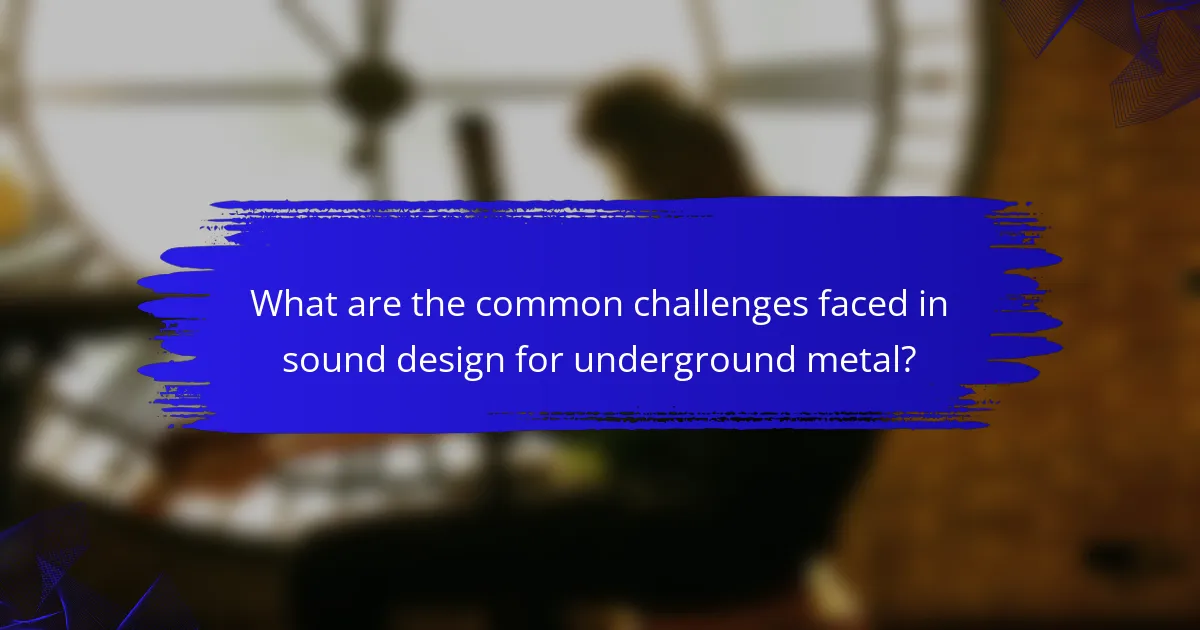
What are the common challenges faced in sound design for underground metal?
Common challenges in sound design for underground metal include achieving clarity in dense mixes, balancing aggressive instrumentation, and maintaining authenticity. These issues arise from the genre’s heavy distortion and complex arrangements. Additionally, limited access to high-quality recording equipment can hinder production quality. Effective use of software tools and techniques can help mitigate these challenges, ensuring the final sound remains powerful and engaging.
How can producers overcome issues with mixing and mastering in metal tracks?
Producers can overcome mixing and mastering issues in metal tracks by utilizing specific techniques and software. Key methods include using equalization to enhance clarity, compression for dynamic control, and reverb to create depth. Software such as Pro Tools, Ableton Live, and specialized plugins like FabFilter Pro-Q and iZotope Ozone can significantly aid in achieving a polished sound. Additionally, collaborating with experienced engineers can provide valuable insights and fresh perspectives on the mixing process.
What are the pitfalls of over-processing in metal sound design?
Over-processing in metal sound design can lead to loss of clarity and authenticity. Excessive effects and manipulation can obscure the original character of instruments and vocals. This results in a sound that may feel artificial or overproduced, diminishing emotional impact. Additionally, over-compression can flatten dynamics, making tracks sound lifeless and reducing their overall energy. Balancing processing techniques is essential to maintain the raw intensity that defines underground metal.
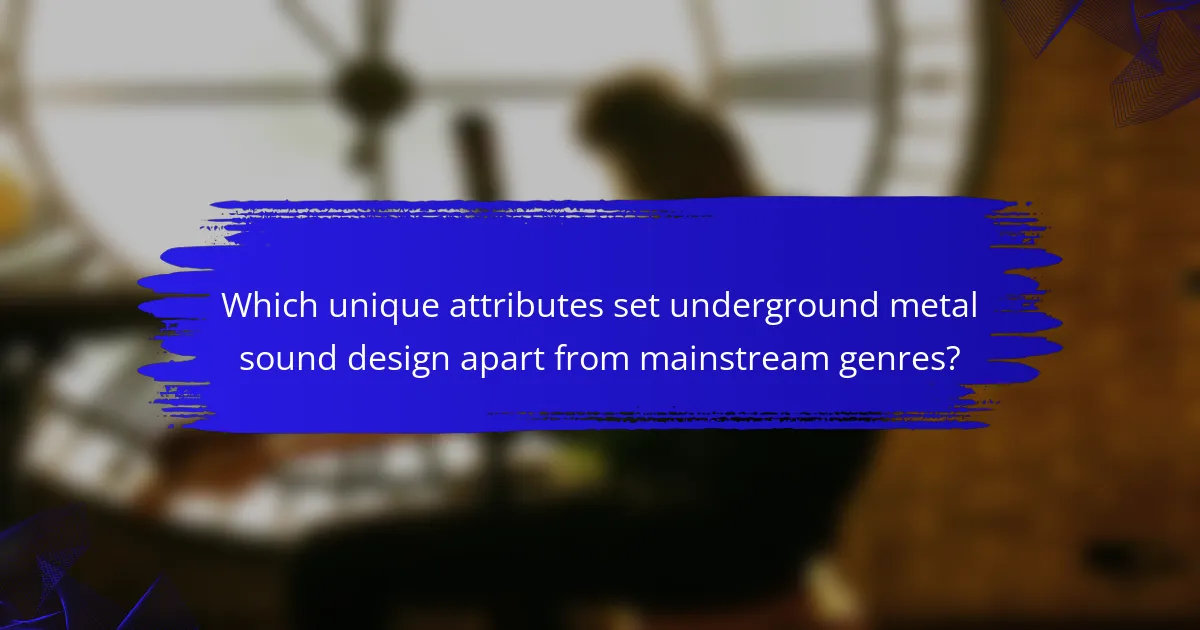
Which unique attributes set underground metal sound design apart from mainstream genres?
Underground metal sound design is characterized by its raw authenticity, innovative use of dissonance, and emphasis on atmosphere. Unique attributes include unconventional instrument choices, intricate layering techniques, and a focus on organic sound textures. These elements create a distinct sonic identity that differentiates underground metal from mainstream genres.
How does the DIY ethos influence sound design choices in underground metal?
The DIY ethos significantly influences sound design choices in underground metal by prioritizing authenticity and creativity. Musicians often utilize unconventional techniques and affordable software to achieve unique sounds. This approach fosters experimentation, leading to distinctive audio textures that challenge mainstream norms. Many artists rely on digital audio workstations like Reaper or Audacity, emphasizing a hands-on, personalized production process. The result is a raw, unfiltered sound that resonates with the underground community’s values of independence and artistic expression.
What cultural elements shape the sound design practices in different underground metal scenes?
Cultural elements significantly influence sound design practices in underground metal scenes, shaping techniques and software choices. Local traditions, musical heritage, and community values drive unique sonic characteristics. For instance, scenes in Scandinavia often incorporate folk elements, while American scenes may emphasize raw production styles. Additionally, the use of specific software varies; for example, many producers in Europe prefer advanced digital audio workstations for intricate layering. These cultural nuances create distinct soundscapes that define each underground metal scene.
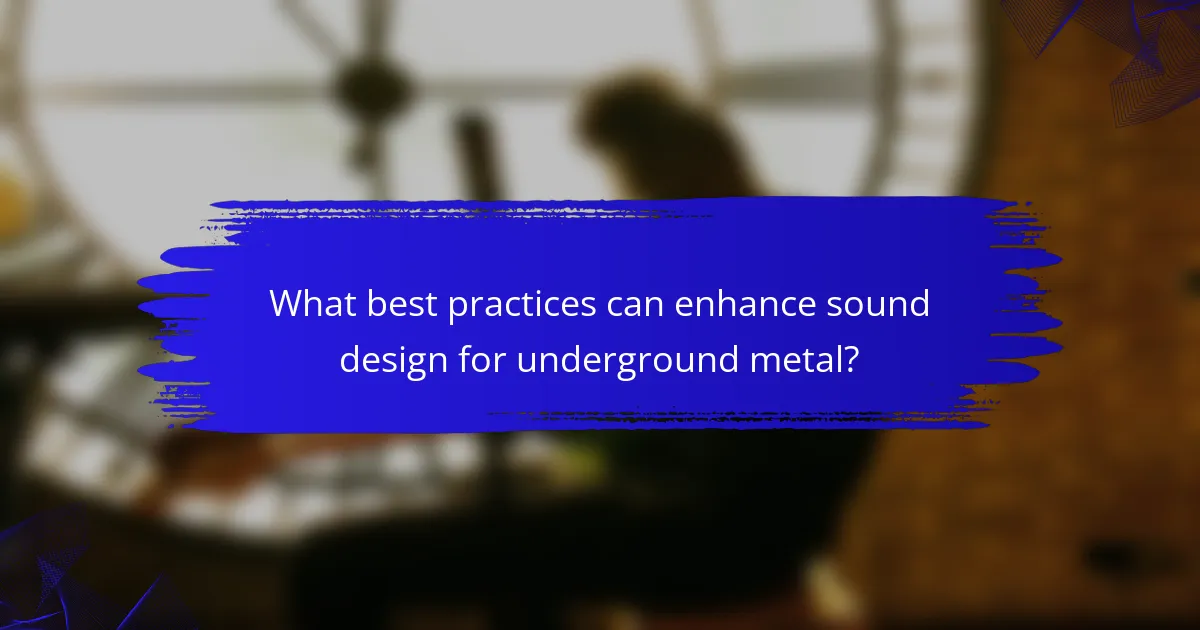
What best practices can enhance sound design for underground metal?
To enhance sound design for underground metal, focus on layering, dynamic range, and unique effects. Utilize techniques like double tracking guitars, experimenting with unconventional instruments, and incorporating ambient sounds. Software such as Pro Tools, Ableton Live, and various VST plugins can help achieve these goals through advanced mixing and mastering capabilities. Prioritize maintaining a raw, authentic sound while ensuring clarity and depth.
How can collaboration with other musicians improve sound design outcomes?
Collaboration with other musicians enhances sound design outcomes by introducing diverse perspectives and techniques. This synergy fosters creativity and innovation, leading to unique soundscapes. Additionally, sharing resources and software knowledge can streamline the production process, resulting in higher quality audio. Collaborators can also challenge each other’s ideas, pushing boundaries and refining techniques, which is essential in underground metal sound design.
What are the benefits of continuous learning and experimentation in sound design?
Continuous learning and experimentation in sound design enhance creativity and skill development. It allows sound designers to explore new techniques, software, and soundscapes, leading to innovative outcomes. Regular practice fosters adaptability, enabling designers to stay current with industry trends and technologies. Experimentation encourages risk-taking, which can result in unique sounds that differentiate an artist’s work in the underground metal scene. Engaging with various sound design resources can reveal new tools and methods, ultimately improving the quality of productions.
What common mistakes should be avoided in underground metal sound design?
To avoid common mistakes in underground metal sound design, focus on authenticity, clarity, and balance. Many designers overlook the importance of maintaining a raw, aggressive sound that defines the genre. Poor mixing can lead to muddy tracks, so ensure each instrument is distinct. Avoid excessive effects that can detract from the core sound. Experimenting with unconventional techniques is essential, but don’t lose sight of the genre’s roots. Lastly, neglecting feedback from peers can result in a lack of perspective on the final product.